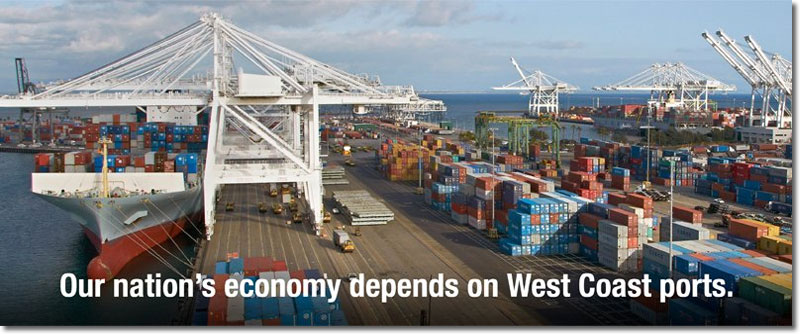West Coast Port Shutdown Could Be 5 Days Away

West Coast seaports could shut down in as soon as five days - hobbling U.S. trade with Asia - if dockworkers and their employers cannot reach a new contract.
Union-led work slowdowns could halt the 29 U.S. West Coast ports, including the Port of Portland, in five to 10 days, the head of the shippers’ association said, urging the union to accept a new offer that includes 3 percent raises (see video above).
James McKenna, the president of the Pacific Maritime Association, said backups and delays at many of the ports are harming farmers, manufacturers and consumers as the flow of goods approaches a “coast-wide meltdown.”
He called on the International Longshore and Warehouse Union to accept management’s second formal contract proposal since negotiations began last May.
“We’re not considering a lockout,” McKenna said on a conference call with reporters, his first public comments since the talks began. “What I’m really saying is that this system will bring it to a stop. Once that happens, we really don’t have a choice.”
Latest: ILWU International President blasts PMA threat to shut down US ports
The association of shipping lines, terminal operators and stevedores made public details of its contract offer, including 3 percent annual raises over five years, retaining employer-paid health care, and raising pensions by 11 percent.
Federal Mediator
The previous six-year contract expired last July. A federal mediator agreed Jan. 6 to intervene in negotiations between the two sides in San Francisco. Negotiators have announced tentative agreements on health care and maintenance of truck chassis used to transport containers from ships.
After the chassis agreement was struck Jan. 27, Wade Gates, a spokesman for the maritime association, said his side was hopeful for a full contract agreement “in the near term.”
Since then, the longshore union made “significant new demands” including the right to unilaterally fire workplace arbitrators, the management association said.
Craig Merrilees, a spokesman for the 20,000-member longshore union, said the two sides continue to make progress as they negotiate this week in San Francisco.
“The number of outstanding issues is getting smaller and the differences are decreasing,” Merrilees said by telephone. “We’ll get there if everyone stays focused on solving the issues, which are easily addressed.”
In a statement Wednesday, the union pledged to keep ports open and goods moving.
Work Slowdowns
McKenna blamed the union for work slowdowns that have contributed to congestion at the largest West Coast ports, including Los Angeles, Long Beach, Oakland, Seattle, Tacoma and Portland. Twenty-two ships were queued up Wednesday at the harbor shared by the Los Angeles and Long Beach ports, up from as few as four in mid-December, according to the Marine Exchange of Southern California, in one measure of the backups confronting shippers.
Since early November, the longshore union has been dispatching fewer crane operators in Los Angeles and Long Beach and slowing cargo movement in Oakland, Seattle and Tacoma, according to a Feb. 3 maritime association presentation. McKenna said productivity at many ports is down by as much as half, suggesting that cargo movement “will collapse under its own weight.”
Delays have kept U.S. raised Christmas trees from reaching consumers in Asia, deprived McDonald’s customers in Japan of french fries, and stranded shipments of Mardi Gras beads bound for New Orleans. Port backups have caused a “black eye” to the U.S. economy and have resulted in job losses, according to a Jan. 16 letter to negotiators from 174 trade associations, including the National Retail Federation.
Ports Should be a Gateway to Trade, Not a Barrier
Among the many topics covered in this year’s annual State of the Union Address, President Obama discussed two issues that are critical for the continued growth of the U.S. economy – international trade and transportation infrastructure. Both of these are priorities the retail industry strongly supports.
We agree with Obama that Trade Promotion Authority – which allows Congress to set principal negotiating objectives for free trade agreements and enhances partnership between the Administration and Congress in return for lawmakers holding a simple up or down vote on the agreements – is essential to completing current trade negotiations with Asia and Europe.

These new agreements would open up new markets for U.S. made goods and would lower costs for U.S. consumers by reducing duties and other trade barriers.
Reduced trade barriers, however, are not enough if the infrastructure needed to move goods in and out of the country remains a barrier itself. Obama rightly noted that “21st century businesses need 21st century infrastructure,” and called for “modern ports, stronger bridges and faster trains.” This is another area where we completely agree.
Infrastructure is the lifeblood for any company that wants to get its goods to market, either here or abroad. Unfortunately, U.S. ports are not as “modern” as they should be and are actually a barrier to our nation’s global competitiveness. And the rest of our transportation system is plagued with bottlenecks that snarl the retail supply chain and reduce efficiency not only for merchants but all industries. It is badly in need of a longterm, bipartisan funding plan to pay for improvements which, as Obama said, would “make this country stronger for decades to come.”
All of this is especially true as we look at West Coast ports and the impact ongoing labor negotiations there have had on businesses that rely on those facilities to move their commerce. It has been more than six months since the contract between the International Longshore and Warehouse Union and the Pacific Maritime Association expired, and nearly nine months of negotiations (which began before the contract expired) have resulted in very little visible or notable progress until recent days. The parties continue to blame each other for slowdowns and crisis level congestion facing the ports.
Moving a container, which normally takes a couple of days, can now take weeks. That translates into additional costs for companies both large and small, potential lost sales to overseas markets, and disappointed consumers when products aren’t on the store shelves. We hear daily from retailers whose deliveries are delayed, manufacturers whose production lines are in danger of shutting down, and farmers whose products are rotting because they can’t get to the port for export, thereby missing opportunities in foreign markets.
Even though labor and management recently agreed to use a federal mediator, the rhetoric has increased, as have the delays. We have repeatedly called on the Obama Administration to engage with the parties and urge them to quickly finalize their contract.
The negotiations impact not only those who work at the ports, but the thousands of companies and millions of workers who depend on the ports to operate efficiently to get their goods to market.
It’s time for President Obama to take the first step toward following through on his call for modern ports by publicly encouraging the completion of the West Coast port negotiations. It’s time for these talks to conclude so full operations can resume and we can address the congestion that continues to face the ports. In order to make “modern” ports, we need modern labor agreements and modern operations so our ports do not pose a barrier to continued economic growth.
Matthew Shay is President and CEO of the National Retail Federation
‘Overseas Competitors’
“Sales of American exports remain clouded in uncertainty across Asia and our overseas competitors eagerly highlight the problems at West Coast ports as a reason not to purchase American-made or -grown products,” the letter said.
In the conference call, McKenna said the two sides remain at odds over wages, pensions, the duration of the contract and arbitration for workplace disputes. He said the sides are “far apart” on some issues and nearing agreement on others.
The National Impact of a West Coast Port Stoppage - NAM & NRF Report
The parties negotiated many of the same issues in 2002 before the maritime association locked out workers for 10 days amid slowdowns. That stoppage, which ended when then President George W. Bush invoked the Taft-Hartley Act, cost the U.S. economy $1 billion a day, the maritime association said.
A 20-day lockout now would cost more than $2 billion a day, the association said in a report last year, including losses to railroads, ocean carriers and the broader economy.
The West Coast ports handled 43.5 percent of containerized cargo in the U.S. in 2013, according to the maritime association’s annual report. Cargo moving through the ports accounts for about 12.5 percent of the U.S. gross domestic product, the association said.
Image Credit: Alexander
Related: Cargo Being Diverted From Congested Long Beach, Los Angeles Ports

Article Topics
Pacific Maritime Association News & Resources
ILWU and PMA come to terms on a tentative new six-year labor deal With deadline way past due, now is the time for a West Coast port labor deal to be struck Report points to signs of optimism for a new ILWU-PMA deal Signs of progress appear to be made on PMA-ILWU negotiations POLA and POLB resume operations, following a brief ILWU work stoppage Industry stakeholders call on White House to aid in West Coast port labor talks ILWU and PMA come to terms on a tentative agreement for health benefits More Pacific Maritime AssociationLatest in Transportation
Ask an Expert: How Shippers Can Prep for Hurricane Season UPS Struggles in First Quarter With Steep Earnings Decline FedEx Announces Plans to Shut Down Four Facilities The Two Most Important Factors in Last-Mile Delivery Most Companies Unprepared For Supply Chain Emergency Baltimore Bridge Collapse: Impact on Freight Navigating Amazon Logistics’ Growth Shakes Up Shipping Industry in 2023 More Transportation













